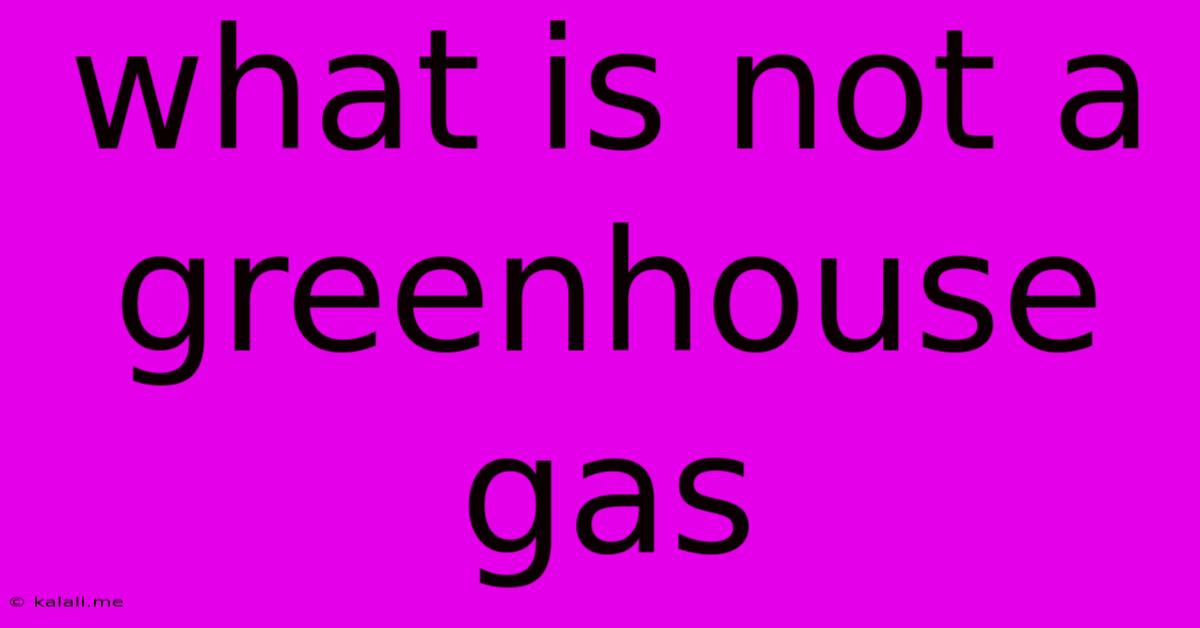What Is Not A Greenhouse Gas
Kalali
Jun 12, 2025 · 3 min read

Table of Contents
What is NOT a Greenhouse Gas? Understanding the Atmosphere's Composition
The Earth's atmosphere is a complex mixture of gases, some of which trap heat and contribute to the greenhouse effect, while others have minimal impact. Understanding which gases are not greenhouse gases is crucial to comprehending climate change and its drivers. This article will delve into the composition of our atmosphere, highlighting gases that don't significantly contribute to global warming. We'll explore what makes a greenhouse gas, and importantly, what doesn't.
What Makes a Greenhouse Gas?
Before we identify non-greenhouse gases, let's briefly review the characteristics of greenhouse gases (GHGs). GHGs are gases that absorb and re-emit infrared radiation (heat) from the Earth's surface, trapping it within the atmosphere. This process is natural and essential for maintaining a habitable temperature on Earth. However, human activities have significantly increased the concentration of certain GHGs, leading to an enhanced greenhouse effect and global warming. The key characteristic is the ability to absorb and re-emit infrared radiation. This ability is determined by the molecular structure of the gas.
Gases that are NOT Significant Greenhouse Gases:
Several gases present in the Earth's atmosphere don't possess the molecular properties necessary to effectively absorb and re-emit infrared radiation. These include:
-
Nitrogen (N₂): Nitrogen is the most abundant gas in the Earth's atmosphere, comprising about 78%. Its symmetrical molecular structure prevents it from effectively interacting with infrared radiation. Therefore, it's considered a non-greenhouse gas.
-
Oxygen (O₂): The second most abundant gas in the atmosphere (about 21%), oxygen also lacks the necessary molecular structure to absorb and re-emit infrared radiation efficiently. It plays a vital role in respiration and combustion, but not in trapping heat.
-
Argon (Ar): Argon is a noble gas and a relatively abundant component of the atmosphere (about 0.9%). Like nitrogen and oxygen, its atomic structure means it doesn't absorb or emit infrared radiation significantly.
-
Neon (Ne), Helium (He), Krypton (Kr), Xenon (Xe): These noble gases are present in trace amounts in the atmosphere and are similarly inert regarding infrared radiation. Their contribution to the greenhouse effect is negligible.
Understanding the Distinction is Key:
It's important to understand that the absence of a significant greenhouse effect from these gases doesn't diminish their importance in the atmosphere. Nitrogen and oxygen are crucial for life on Earth. However, when discussing climate change and its drivers, focusing on gases with significant radiative forcing (the ability to influence the Earth's energy balance) is essential.
The Role of Trace Gases:
While the gases listed above are not significant contributors, it's worth noting that even trace amounts of some gases can have a significant impact on climate. This highlights the complexity of the Earth's climate system. The focus on major GHGs like carbon dioxide, methane, and nitrous oxide remains vital in understanding and mitigating climate change.
Conclusion:
This article clarifies what constitutes a greenhouse gas and specifically addresses those that are not significant contributors. While nitrogen, oxygen, argon, and other noble gases are essential parts of our atmosphere, their lack of interaction with infrared radiation distinguishes them from the primary drivers of the greenhouse effect and global warming. Understanding this distinction is critical for effective climate change discussions and solutions.
Latest Posts
Latest Posts
-
How Much Legs Does A Ant Have
Jun 13, 2025
-
Is Soda An Acid Or Base
Jun 13, 2025
-
The Post Office Of The Cell Is The
Jun 13, 2025
-
What Does Yellow Clock Mean In Outlook
Jun 13, 2025
-
What Is The Opposite Of Artificial
Jun 13, 2025
Related Post
Thank you for visiting our website which covers about What Is Not A Greenhouse Gas . We hope the information provided has been useful to you. Feel free to contact us if you have any questions or need further assistance. See you next time and don't miss to bookmark.